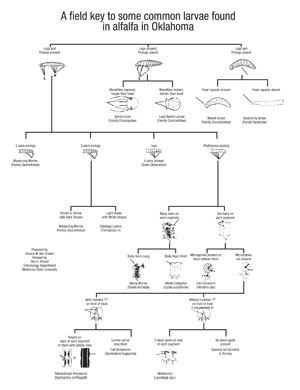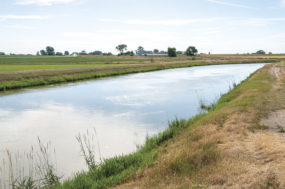This key is designed to serve as a guide to identification of the more typical larvae of some of the common insect species found in many alfalfa fields during the mid-to-late season. A 10-power to 15-power hand lens will be most helpful in using this key.
The identifying characteristics used are based upon those found on full-grown or nearly full-grown larvae and may not necessarily occur on newly hatched larvae. This key should not be used for larvae occurring in crops other than alfalfa.
Survey methods
Insect counts in alfalfa are taken on a per-10 sweep basis during the active growing season. Using a standard 15-inch sweep net, a sweep consists of a half-circle or a 180-degree arc allowing the net to sweep into the foliage as the surveyor walks across the field.
A sweep is taken with every one or two steps. To get a good overall count, 10 sweeps should be taken in at least five well-spaced places in the field. Numbers for each species should be averaged and reported as the number per 10 sweeps. Larger populations (aphids, etc.) can be reported as the number per sweep.
Newly cut or overwintering alfalfa infestations are recorded as the number per square foot of crown. A wire form containing one square foot can be used as a measurement gauge.
All insects within this area are counted and recorded as the number of insects per square foot. Depending on the size of the field, three to five counts should be taken in each field.
Newly planted alfalfa should be checked on a per-linear-foot basis. Count and report the number of insects present on the plants in a foot of drill row. Counts should be made in at least five locations throughout the field.
Descriptions of larvae
• Corn earworm (Heliothis zea)
The main distinguishing characteristic of this species is the distinct, short, sharp microspines, resembling whiskers, present between the longer hairs on the back.
This gives the larva an “unshaven’’ appearance when viewed with a 10-power to 15-power hand lens. (Do not confuse the pebbled or granular skin of other larvae with the microspines.) Body color varies greatly from light to dark green, pink or brownish-yellow.
When fully grown, the larvae measure up to 1.5 inches in length. This destructive pest causes damage by feeding on foliage.
• Webworms (Several species)
This may be one of three closely related species, the garden webworm (Achyra rantalis), the alfalfa webworm (Loxostege commixtalis) or the beet webworm (Loxostege sticticalis), which cannot be easily separated in the field.
All of these larvae are greenish-yellow in color with three distinct, elongate, black spots arranged in a triangle on the upper portion of the side of each segment, with the exception of the front three. Fully grown larvae measure about one inch in length.
These larvae are foliage feeders and may move into alfalfa fields from other nearby crops or weeds. They usually spin webs over the leaves upon which they are feeding, hence the common name “webworms.”
• Green cloverworm (Plathypena scabra)
This is the only species commonly found in alfalfa that has four pairs of prolegs. Body color is green.
Younger larvae have two longitudinal white stripes on each side, but these are absent in the last instar. They may be up to one inch long when fully grown. They are primarily foliage feeders.
• Alfalfa caterpillar (Colius eurytheme)
These larvae are covered with many short hairs. Body color is green with a narrow white stripe down each side. Inside each stripe is a very fine red line.
They measure up to 1.5 inches in length when fully grown. They are foliage feeders.
• Cabbage looper (Trichoplusia ni)
These larvae move in a characteristic “looping” manner. They are larger at the back end and taper toward the head. The body is green with narrow white lines running the length of the body and is without black spots.
These larvae are up to 1.6 inches in length when fully grown. They are usually found feeding on leaves, giving the foliage a ragged appearance.
• Fall armyworm (Spodoptera frugiperda)
These larvae usually have a distinct, broad, white inverted “Y” present on the front of the head (not to be confused with a narrow inverted “V’’ found on a few other species).
The body varies from light tan to green to dark brown or nearly black in color with three widely separated narrow yellowish-white stripes down the back.
On each side are three more broad longitudinal lines side by side with the top, brown; the middle, reddish; and the bottom, yellow with reddish mottlings.
These larvae measure up to 1.3 inches in length when fully grown. They are primarily foliage feeders.
• Woolly worms (Family Arctiidae)
This may be one of several members of this family. One of the common ones is the salt-marsh caterpillar (Estigmene acaea), covered with long black, brown or yellowish hairs.
The larvae of this species may become almost two inches in length when fully grown. The pests in this family are primarily foliage feeders.
• Measuring worms (Family Geometridae)
These larvae may have two or three pairs of prolegs. Those with three pairs are usually brown or yellowish brown with dark stripes. They may measure one inch or more when fully grown. They are foliage feeders.
• Yellowstriped armyworm (Spodoptera ornithogalli)
These larvae vary in color from pale gray to jet black, but all will have two yellow stripes down the back. The gray individuals have two narrow dark triangles on the back of each segment, but these cannot be distinguished in the darker forms. The head is mostly brown.
These larvae measure up to 1.3 inches in length when fully grown. They are primarily foliage feeders.
• Weevil larvae (Family Curculionidae)
These larvae are whitish or yellowish, C-shaped, more or less cylindrical and legless.
• Lady beetle larvae (Family Coccinellidae)
Body color is generally dark with bright yellow, orange or red markings. The body is covered with numerous spines.
In a few species, the body is covered with a waxy secretion and resemble mealybugs, but a check of the mouthparts will clear up the confusion (mealybugs have piercing-sucking mouthparts while lady beetle larvae have biting mouthparts).
This group is highly beneficial, with both larvae and adults feeding on aphids, spider mites, eggs and young of many other pests.
• Syrphid fly larvae (Family Syrphidae)
This may be one of several members of this family. They are cylindrical and somewhat peg-shaped with protuberances on most segments.
They usually are light green in color and the entire body is covered with short, colorless microspines. They are found crawling about on plants feeding on aphids.
• Aphid-lions (Family Chrysopidae)
These small, active, light brown larvae measure up to 0.5 inch in length when full grown. Both larvae (aphid-lions) and adults (lacewing flies) are beneficial since they feed upon aphids or plant lice and other small pests.
Be sure the specimen suspected of being in this group have biting mouthparts. There are several other groups, such as true bugs, Order Hemiptera, which are similar in body shape, but differ from them by having piercing-sucking mouthparts.
—Excerpts from Oklahoma State University Entomology and Plant Pathology newsletter









